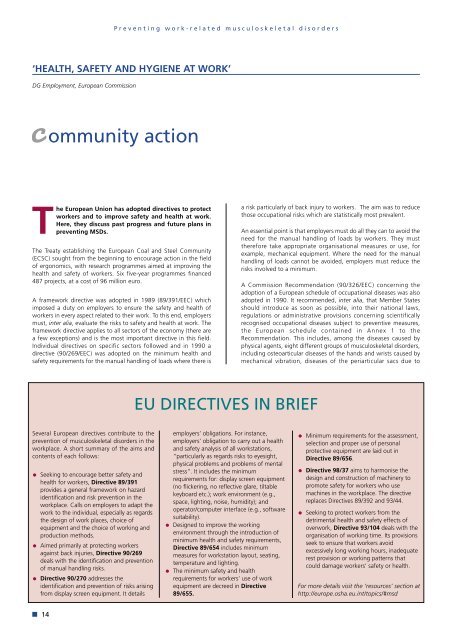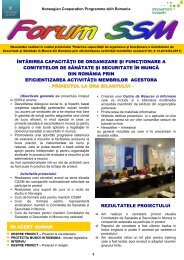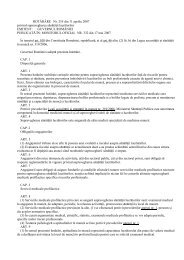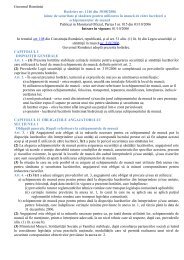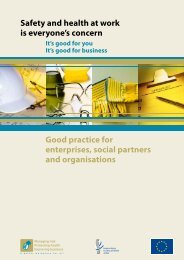Preventing work-related musculoskeletal disorders - European ...
Preventing work-related musculoskeletal disorders - European ...
Preventing work-related musculoskeletal disorders - European ...
Create successful ePaper yourself
Turn your PDF publications into a flip-book with our unique Google optimized e-Paper software.
<strong>Preventing</strong> <strong>work</strong>-<strong>related</strong> <strong>musculoskeletal</strong> <strong>disorders</strong><br />
‘HEALTH, SAFETY AND HYGIENE AT WORK’<br />
DG Employment, <strong>European</strong> Commission<br />
community action<br />
The <strong>European</strong> Union has adopted directives to protect<br />
<strong>work</strong>ers and to improve safety and health at <strong>work</strong>.<br />
Here, they discuss past progress and future plans in<br />
preventing MSDs.<br />
The Treaty establishing the <strong>European</strong> Coal and Steel Community<br />
(ECSC) sought from the beginning to encourage action in the field<br />
of ergonomics, with research programmes aimed at improving the<br />
health and safety of <strong>work</strong>ers. Six five-year programmes financed<br />
487 projects, at a cost of 96 million euro.<br />
A frame<strong>work</strong> directive was adopted in 1989 (89/391/EEC) which<br />
imposed a duty on employers to ensure the safety and health of<br />
<strong>work</strong>ers in every aspect <strong>related</strong> to their <strong>work</strong>. To this end, employers<br />
must, inter alia, evaluate the risks to safety and health at <strong>work</strong>. The<br />
frame<strong>work</strong> directive applies to all sectors of the economy (there are<br />
a few exceptions) and is the most important directive in this field.<br />
Individual directives on specific sectors followed and in 1990 a<br />
directive (90/269/EEC) was adopted on the minimum health and<br />
safety requirements for the manual handling of loads where there is<br />
a risk particularly of back injury to <strong>work</strong>ers. The aim was to reduce<br />
those occupational risks which are statistically most prevalent.<br />
An essential point is that employers must do all they can to avoid the<br />
need for the manual handling of loads by <strong>work</strong>ers. They must<br />
therefore take appropriate organisational measures or use, for<br />
example, mechanical equipment. Where the need for the manual<br />
handling of loads cannot be avoided, employers must reduce the<br />
risks involved to a minimum.<br />
A Commission Recommendation (90/326/EEC) concerning the<br />
adoption of a <strong>European</strong> schedule of occupational diseases was also<br />
adopted in 1990. It recommended, inter alia, that Member States<br />
should introduce as soon as possible, into their national laws,<br />
regulations or administrative provisions concerning scientifically<br />
recognised occupational diseases subject to preventive measures,<br />
the <strong>European</strong> schedule contained in Annex 1 to the<br />
Recommendation. This includes, among the diseases caused by<br />
physical agents, eight different groups of <strong>musculoskeletal</strong> <strong>disorders</strong>,<br />
including osteoarticular diseases of the hands and wrists caused by<br />
mechanical vibration, diseases of the periarticular sacs due to<br />
EU DIRECTIVES IN BRIEF<br />
Several <strong>European</strong> directives contribute to the<br />
prevention of <strong>musculoskeletal</strong> <strong>disorders</strong> in the<br />
<strong>work</strong>place. A short summary of the aims and<br />
contents of each follows:<br />
• Seeking to encourage better safety and<br />
health for <strong>work</strong>ers, Directive 89/391<br />
provides a general frame<strong>work</strong> on hazard<br />
identification and risk prevention in the<br />
<strong>work</strong>place. Calls on employers to adapt the<br />
<strong>work</strong> to the individual, especially as regards<br />
the design of <strong>work</strong> places, choice of<br />
equipment and the choice of <strong>work</strong>ing and<br />
production methods.<br />
•<br />
Aimed primarily at protecting <strong>work</strong>ers<br />
against back injuries, Directive 90/269<br />
deals with the identification and prevention<br />
of manual handling risks.<br />
• Directive 90/270 addresses the<br />
identification and prevention of risks arising<br />
from display screen equipment. It details<br />
employers’ obligations. For instance,<br />
employers’ obligation to carry out a health<br />
and safety analysis of all <strong>work</strong>stations,<br />
“particularly as regards risks to eyesight,<br />
physical problems and problems of mental<br />
stress”. It includes the minimum<br />
requirements for: display screen equipment<br />
(no flickering, no reflective glare, tiltable<br />
keyboard etc.); <strong>work</strong> environment (e.g.,<br />
space, lighting, noise, humidity); and<br />
operator/computer interface (e.g., software<br />
suitability).<br />
• Designed to improve the <strong>work</strong>ing<br />
environment through the introduction of<br />
minimum health and safety requirements,<br />
Directive 89/654 includes minimum<br />
measures for <strong>work</strong>station layout, seating,<br />
temperature and lighting.<br />
• The minimum safety and health<br />
requirements for <strong>work</strong>ers’ use of <strong>work</strong><br />
equipment are decreed in Directive<br />
89/655.<br />
• Minimum requirements for the assessment,<br />
selection and proper use of personal<br />
protective equipment are laid out in<br />
Directive 89/656.<br />
• Directive 98/37 aims to harmonise the<br />
design and construction of machinery to<br />
promote safety for <strong>work</strong>ers who use<br />
machines in the <strong>work</strong>place. The directive<br />
replaces Directives 89/392 and 93/44.<br />
•<br />
Seeking to protect <strong>work</strong>ers from the<br />
detrimental health and safety effects of<br />
over<strong>work</strong>, Directive 93/104 deals with the<br />
organisation of <strong>work</strong>ing time. Its provisions<br />
seek to ensure that <strong>work</strong>ers avoid<br />
excessively long <strong>work</strong>ing hours, inadequate<br />
rest provision or <strong>work</strong>ing patterns that<br />
could damage <strong>work</strong>ers’ safety or health.<br />
For more details visit the ‘resources’ section at<br />
http://europe.osha.eu.int/topics/#msd<br />
14


